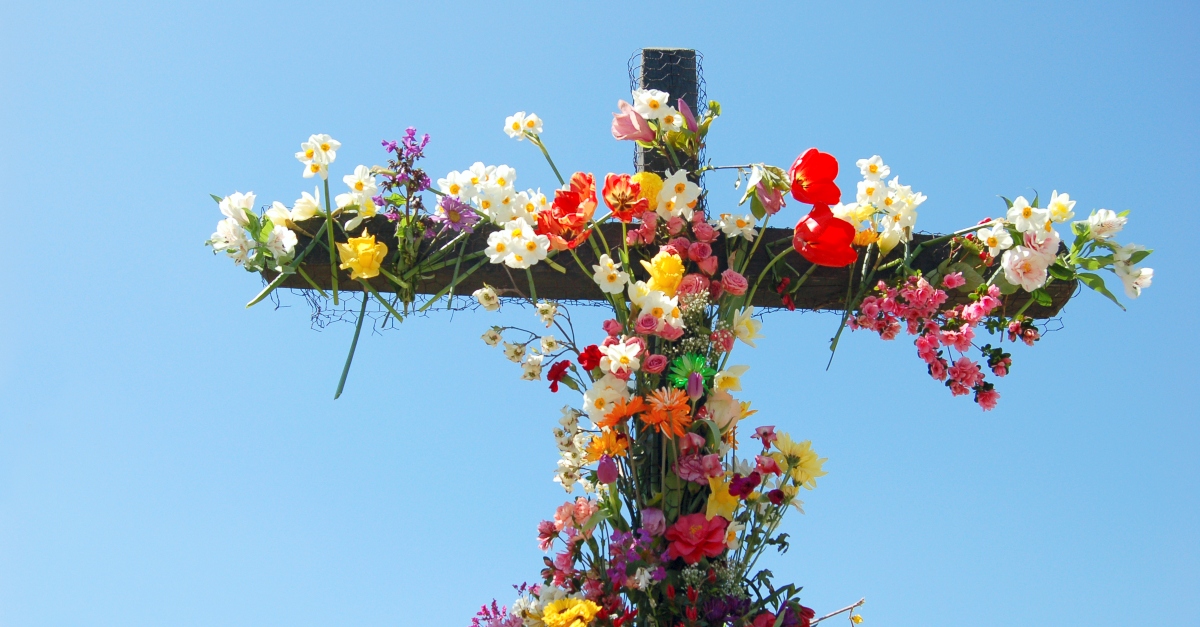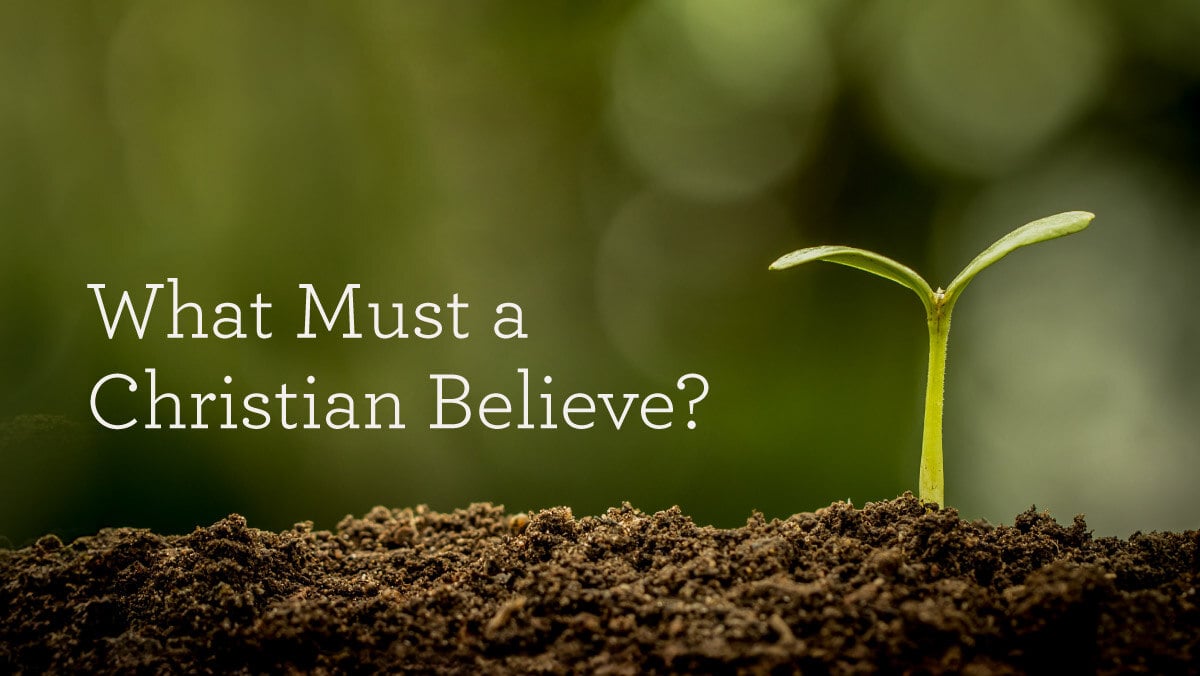During Holy Week, I love seeing the large wooden crosses with the traditional purple drape that churches display on their property for others to see. On Good Friday, a black sash is placed on the cross to symbolize the death of Christ.
This is replaced by a white sash on Sunday to symbolize the resurrection of Christ. Many churches also create a bouquet of fresh flowers to place on the cross on Easter morning in a practice that is known as “flowering the cross.”
Each year, I eagerly await the changing colors of the sash and the vibrant flowers on Resurrection Sunday to remind me of the new life Christ offers us all.
When thinking about this practice that various Christian denominations use, I am reminded of beautiful biblical truths. The draped and flowering cross gives us a visual reminder of the life-changing news of Easter.
The Purple Drape: Jesus Christ the King
Traditionally, a purple drape is placed on the Easter cross on Palm Sunday, which is the official start of Holy Week.
On this day, we remember Jesus’ Triumphal Entry, where He entered Jerusalem riding a donkey (Luke 19:28-38). Crowds of people waved palm branches while shouting “Hosanna” (Matthew 21:9; Mark 11:9-10).
Purple is a proper color for Palm Sunday because of the color’s association with royalty. Christ’s triumphal entry fulfilled the prophecy of Zechariah 9:9, which says, “Rejoice greatly, Daughter Zion! Shout, Daughter Jerusalem! See, your king comes to you, righteous and victorious, lowly and riding on a donkey, on a colt, the foal of a donkey.” Jesus is that promised King, the long-awaited Messiah.
Unlike worldly kings who rule by brute force and war, Jesus is the humble King. He did not conquer with a sword or fist but by laying down His life (John 10:11).
When Christians see the purple-draped cross, we remember our true King, who humbly entered Jerusalem and who will come again soon as the King of kings and Lord of lords (Revelation 19:16).
The Black Drape: Christ’s Death to Pay for Our Sins
Churches normally exchange the purple drape for a black drape on Good Friday. On this day of Holy Week, we remember Jesus’ death on the cross. Although Jesus was completely innocent, He allowed the Roman soldiers to nail Him to the cross and crucify Him (Luke 23:4,14,22,47; John 10:18).
The agony of crucifixion was intensified by the weight of all the sin He bore on the cross (2 Corinthians 5:21; 1 Peter 2:24) and the pain of being separated from the Father (Matthew 27:46).
The black colored cloth reminds us of the darkness that Jesus endured. He willingly gave up His life so He could save us from our sins, paying the penalty for our wrongdoing. In the darkness of pain, He bore our sins (Isaiah 53:5). Also, there was physical darkness as Jesus hung on the cross (Matthew 27:45).
Many congregations choose to place a crown of thorns on the Easter cross when it is draped in black cloth. This correlates with the biblical account since a crown of thorns was placed on Jesus’ head before the crucifixion when the soldiers mocked Him.
Ironically, they hailed Him as the “king of the Jews,” which is true (Matthew 27:28-29; Mark 15:17-18; John 19:2-3). He is the great King of all, yet the people mocked and despised Him (Isaiah 53:3).
When we see the Easter cross on Good Friday, we can pause and reflect on the extent of Jesus’ love in dying for us (Ephesians 3:18).
He endured great pain and shed His blood to bring us salvation. Nothing can compare with this act of love to free us from sin’s bondage. He deserves all our love and praise.
The White Drape: Good News of Jesus’ Resurrection
On Resurrection Sunday, the Easter cross is draped with a white cloth. The transition from death to life is clearly seen in the symbolism of the changing drapes.
On Good Friday, Jesus died and was placed in a tomb owned by Joseph of Arimathea (Matthew 27:57-61). However, that was not the end. Early on Sunday morning, the women found that the tomb was empty (Luke 24:1-2).
Jesus rose to life on the third day, as He had said (Matthew 16:21; Mark 8:31; 9:31; 10:33; Luke 9:22). The women saw the risen Lord and told the disciples, making them the first people to spread the good news to others (Matthew 28:9; Luke 24:3-10).
Christ also appeared to His disciples, to His half-brother James, and to over 500 people at once (1 Corinthians 15:5-8). As the angel declared: “He has risen!” (Luke 24:6, BSB). The truth that He is risen indeed is still the resounding message of Easter.
Both Jesus’ death and resurrection are essential truths of the Christian faith and the gospel message. When Jesus rose to life, He proved that He is the Son of God. He paid the penalty for our sins and defeated the power of death.
Because He was resurrected, we have a secure hope of eternal life. Thus, as we consider the white drape on the Easter cross, let us remember the good news of the empty tomb, that Jesus truly is our risen Savior and Lord.
Flowering of the Cross: New Life and Hope
Although not all churches practice flowering the cross, it is a lovely act that reminds us of the truth of Jesus’ resurrection and the new life He gives us.
Every year, as I look at the flowers adorning the Easter cross, I think about how amazing it is that the horror of the cross produced the gift of salvation. Jesus died to give us life, and He suffered on the cross to do so. A terrible method of killing is now a hope-filled symbol of our salvation and faith.
Furthermore, the symbol of the flowering cross beautifully illustrates how believers have been set free from the terrible chains of sin and death. Our old life is gone, crucified with Christ, and He has given us a new life as new creations in Him (2 Corinthians 5:17; Galatians 2:20).
Even though our past might be dark and marred with the ugliness of sin, we have been washed clean and given a new identity (see 1 Corinthians 6:11). No longer are we children of darkness, but children of the light — sons, and daughters of God (John 1:12; Ephesians 5:8; 1 Thessalonians 5:5).
Therefore, whether you participate in placing flowers on an Easter cross this year or decide to make your own at home, let the fresh blooms emerging from the cross remind you of the powerful and life-changing message of Easter.
Jesus’ death and resurrection changed the world. Humankind was lost in the darkness of sin, but now there is hope. Those who place faith in Christ receive forgiveness of sins, eternal life, and a new life characterized by a loving relationship with the Lord. We celebrate these truths on Easter Sunday.
Christian Unity and the Easter Cross
In addition to the deep, biblical truths connected with the color of the drapes and the practice of flowering the cross, the Easter cross also connects us as the body of Christ.
Regardless of denomination or tradition, churches can practice setting up a cross and draping it during Lent and Holy Week and participate in flowering the cross. I find it amazing how the cross so easily breaks through divisions.
The good news of Jesus’ death and resurrection unites all believers because it is the foundation of our faith and salvation.
Whenever I spot a wooden cross draped with a purple cloth fluttering in the wind, I am prompted to remember that believers in Christ, regardless of denomination affiliation, are part of the global church. We are sisters and brothers, united as the body of Christ (1 Corinthians 12:27).
All people who have placed faith in Jesus can agree on the foundational truths of Christianity and the gospel. We each acknowledge that Jesus Christ, fully God, and fully man, came to earth to die as a substitute for us, paying the price of our sins.
He was buried in a tomb and rose to life on the third day. In Him alone, we find salvation, hope, and everlasting love. When churches display a cross outside their church during Holy Week, they declare the truth of Christ’s saving grace. That is something we can all celebrate together in Christian unity.
What Does This Mean?
The Easter cross is more than a holiday decoration. Christians view the cross as a symbol of salvation and faith in Jesus.
Numerous churches choose to drape their crosses with various colored cloths during Holy Week to commemorate the significant events that occurred in history, including Christ’s triumphal entry, His sacrificial death on the cross, and His resurrection.
Churches may also participate in the flowering of the cross, a beautiful practice that symbolizes life from death. The cross that was meant to kill and defeat Jesus is now a symbol of His love and sacrifice. He is not dead but alive. Whenever we see an Easter cross, we can remember the wonderful truth of the gospel.
For further reading:
What Is the Significance of the Cross?
Photo Credit: ©iStock/Getty Images Plus/Malven
Sophia Bricker is a freelance writer who enjoys researching and writing articles on biblical and theological topics. In addition to contributing articles about biblical questions as a contract writer, she has also written for Unlocked devotional. She holds a BA in Ministry, a MA in Ministry, and is currently pursuing an MFA in Creative Writing to develop her writing craft. As someone who is passionate about the Bible and faith in Jesus, her mission is to help others learn about Christ and glorify Him in her writing. When she isn’t busy studying or writing, Sophia enjoys spending time with family, reading, drawing, and gardening.




